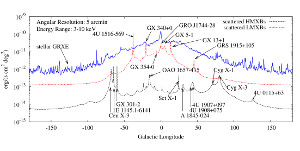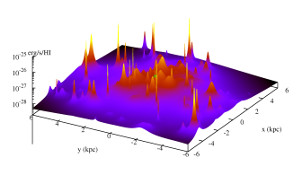 |
|
Fig. 1:
Components of the GRXE on the plane of the Galaxy in
the 3-10keV range. The scattered GRXE component is shown separately for
two types of XBs, low-mass XBs (LMXBs) and high-mass XBs (HMXBs). The
labels indicate the names of the individual sources giving rise to the
peaks in the scattered GRXE profile.
|
 |
 |
|
Fig. 2:
Map of the scattered GRXE emission on the sky. The emission is expected to closely follow the distribution of interstellar
gas: indeed, the map shows that the intensity tends to be stronger on the plane of the Galaxy, where most
of the interstellar gas is concentrated. Very dense regions of gas, such as dense molecular clouds, are also clearly visible
as prominent bright features in the map.
|
 |
 |
|
Fig. 3:
Latitude profiles for the scattered GRXE for two models of X-ray binary populations in the Galaxy, motivated by observations
in our own Galaxy ("scattered XBs", red crosses) and in other galaxies ("scattered Monte Carlo XBs", black crosses). Both profiles
follow the gas distribution, while the stellar distribution (blue stars) is much broader. Both models are consistent with
the limits of 10-20% on unresolved GRXE from Revnivtsev et al 2009 in the region shown by the vertical bars.
|
 |
 |
|
Fig. 4:
Heating of the interstellar gas per hydrogen atom on the Galactic plane, resulting from the absorption of X-rays
from XBs, plotted in the vertical direction and in color scale for the case of a simulated XBs population. X-rays
may be an especially important source of heating in the central part of the Galaxy.
|
|  |
The Galactic disk of the Milky Way can be seen from Earth as a band of stars across the night sky
interrupted by narrow dark 'dust lanes'. There the dust in the gaseous disk blocks the visible light of the
background stars. Thus, many of the most interesting features of our Milky Way can only be observed in
X-rays. Along with the point X-ray sources which populate the Milky Way, we observe an apparently diffuse
X-ray emission concentrated in the Galactic plane, known as the Galactic Ridge X-ray emission (GRXE).
The origin of this emission has puzzled astrophysicists ever since it was first identified by Diana Worrall
and collaborators in 1982. Because of the difficulty in resolving the GRXE into point sources, it was initially
believed that its nature might be truly diffuse, and that its origin might actually be a Galactic plasma rather
than discrete stellar sources.
It was soon realised, however, that the temperature of the gas producing such an emission would have to
be close to tens of millions of degrees - a temperature far too high for the gas to be gravitationally bound to
the Galaxy. It was therefore suggested that the GRXE might be composed of a large number of stars fainter
in X-rays than accreting black holes and neutron stars (but still more luminous than our Sun). Although it
was not possible to actually see them at the time, the hope was that with the increasing sensitivity of new
X-ray satellites, one day a multitude of faint X-ray sources could be fully resolved.
For decades, attempts were made to resolve this emission, yet most of it still appeared to be diffuse.
Finally in 2009, Revnivtsev, Sazonov and collaborators pointed the Chandra X-ray observatory towards a
very small region of the sky near the Galactic centre for 12 entire days and could resolve over 80% of the emission in this region.
Along with this direct observation of the sources, other indirect probes have strengthened the case for a
discrete origin of the GRXE in the last few years. In particular, the large-scale morphology of the emission
closely follows that of the Galactic stellar population, and the GRXE spectrum shows good agreement with
the combined spectra of the sources expected to directly contribute to the emission.
Thus it seemed that a general consensus on the discrete nature of the emission had been reached, and
that the mystery of the origin of the GRXE had been conclusively solved.
This, however, may not be the whole story. Recent work by researchers at the Max Planck Institute
for Astrophysics suggests that the GRXE might have an additional, truly diffuse component after all. This
would arise not from the thermal emission of a very hot plasma but rather from the reprocessing by the
interstellar gas of the X-ray radiation produced by luminous X-ray binary sources located in the Galaxy.
X-ray binaries are the most luminous sources of X-rays in galaxies such as the Milky Way. These binary
systems emit X-ray radiation when material from a so-called donor star falls into the strong gravitational
field of a compact object, such as a neutron star or a black hole. This X-ray radiation illuminates the atoms
and molecules in the Galactic interstellar gas, which then scatter the incoming photons in different directions
and at different energies. Thanks to this reprocessing of the original radiation, the resulting emission appears
truly diffuse to the observer.
The contribution of this component would closely follow the distribution of the gas in the Galaxy. Therefore
the large-scale morphology of the diffuse component should be characteristically different from that of
the stellar component. In particular, the diffuse component would be 'thin' compared to the stellar one,
since the gas distribution does not reach as far out of the Galactic plane as does the stellar population.
Additionally, very dense regions of gas such as molecular clouds would produce very prominent features in
the scattered GRXE component. If a high enough angular resolution is available, variations in the strength
of the GRXE emission will then be observable close to these regions.
It was found that on the Galactic plane, where most of the interstellar gas is concentrated, the scattered
GRXE can contribute at least 10-30%. The interest in studying the diffuse component of the GRXE however goes
beyond the sole purpose of determining its origin. This radiation also tells us about the distribution and
luminosity of the X-ray binaries themselves.
Direct, exhaustive studies of the Galactic X-ray binary population are extremely diffcult even if one
considers only the recent history. This is due to two main effects: on the one hand, severe uncertainties in
determining the distance to these systems and instrumental flux limitations limit our view of this population
beyond the Galactic centre; on the other hand, these sources are transient. This means that any time
only a few of these sources are active and visible. Nevertheless, if we directly compare the fraction of the
unresolved emission observed in different regions of the sky with the scattered component obtained from
observed or simulated Galactic X-ray binary populations, we will be able to indirectly obtain constraints on
the properties of the population of X-ray sources in the Galaxy.
Because the scattered light travels a longer path to reach the observer compared to light directly contributed
by point sources, the scattered GRXE component also depends on the overall X-ray activity of the
Galaxy in the past 10,000 to 30,000 years. Studies of the relative contribution of the scattered component to
the GRXE therefore will allow us to look back at the history of the Galactic X-ray output over this period
of time.
This research therefore highlights a new way in which the GRXE, whose origin might be even more
diverse than initially thought, can provide us with a wealth of information on the X-ray sources, both faint
and luminous, which populate our galaxy.
Radiation produced by X-ray binaries is of course not only scattered, but also absorbed by atoms and molecules,
and therefore contributes to the heating of the interstellar gas.
The lower energy ultra-violet photons are usually the dominant source of heating in diffuse interstellar clouds.
The X-ray photons can however penetrate deep inside the dense molecular clouds where the ultra-violet
photons cannot reach, since they are absorbed by the outer layers.
The contribution of the X-ray binary sources to the heating rate in the interstellar medium was in fact found to
be significant, suggesting that these sources may play a crucial role in determining the multiphase
structure of the interstellar medium.
Margherita Molaro, Rishi Khatri, Rashid Sunyaev
References:
1) Revnivtsev, M., Sazonov, S., Churazov, E., Forman, W., Vikhlinin, A.,
Sunyaev, R., "Discrete sources as the origin of the Galactic X-ray ridge
emission", Nature, 458, 7242, pp.1142-1144,2009
2) Molaro, M., Khatri, R., Sunyaev, R., "A thin diffuse component of the
Galactic ridge X-ray emission and heating of the interstellar medium
contributed by the radiation of Galactic X-ray binaries", Astronomy &
Astrophysics, 564, A107, 2014
|





